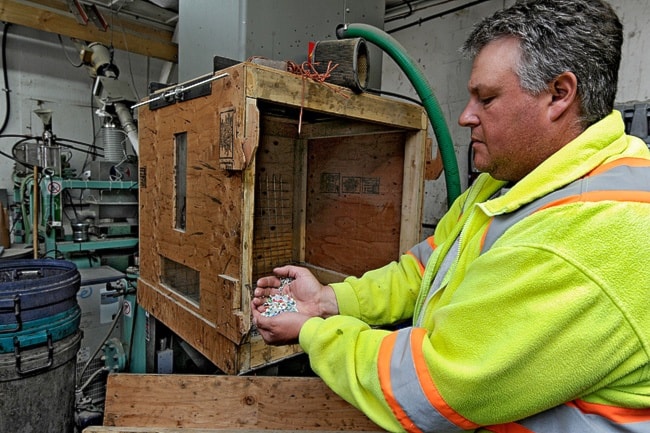It’s been nearly two years since a partner project between P&M Recycling Depot, Cold Climate Innovation and the Canadian Northern Economic Development Agency brought an innovative plastic-to-oil machine to Whitehorse.
In its pilot run, the machine has proven to save money, cut down on emissions and produce oil from plastic, which can be used to heat buildings or refined to power diesel cars.
The large, green machine sitting in the back corner of P&M has the ability to turn mostly worthless plastic, such as grocery bags and yogurt containers, into fuel.
It can process 240 kilograms of plastic every day and produce enough oil to continuously heat 70 Yukon homes.
The emissions from the machine are equivalent to a few people standing and breathing in a single room.
The resulting oil is a blend of gasoline, diesel, kerosene, and some heavy oils.
It can be fed directly into an oil furnace, or could be processed further into something that could go straight into a diesel car.
Pat McInroy, the owner of the recycling depot, stood next to the machine recently, a full colour spectrum of granulated plastic in his hands, ready to be processed and converted into fuel.
The machine, which was purchased for about $200,000 through distributor E-N-ergy comes from Japan, where it’s manufactured by a company called Blest.
“In 10 years it pays for itself in saved heating costs,” said McInroy.
“It could possibly be the next oil boom. It gets rid of the plastic in the landfill and you don’t have to explore. The economics up here make it a worthwhile venture.”
McInroy saves not only in annual heating costs, but in the previous labour costs for sorting and baling the plastic, and then shipping it off to be processed.
Recycling centres in the south will pay for the number ones and number twos, which comprise a lot of beverage containers and related products.
Polyvinyl chloride, the number three plastic, is toxic.
The rest, which the machine deals with, are not profitable to recycle, but can be converted into fuel.
Robert Cooke, project officer with Cold Climate Innovation, said the machine has proven to be economically viable, especially when considering the shipping costs of sending out plastic to be recycled.
“The plan is for us to carry on working with the machine and produce a lot of oil over the next 12 months,” he said.
Some issues that need to be addressed are refining the sorting methods - if the wrong type of plastic ends up in the mix, it can lead to high water content in the oil - and improving the granulation methods, a required step to get the plastic into the machine.
Both Cooke and McInroy agree that similar machines could have future homes in the communities.
“It would be an ideal solution,” said Cooke. “Rather than the communities having to ship their plastics into Whitehorse, they could do it themselves. There’s definitely a future for these machines.”
The machine was modified to function in a colder climate - the cooling in the system is done with antifreeze instead of water - but McInroy said its success in Whitehorse has proven it can work anywhere in North America.
“I can see it in the communities,” he said, in areas where there’s too much permafrost and rock for proper landfills.
“In Old Crow, where they’ve had problems with plastic, they could produce their own heating oil, even if it’s only for a few buildings. It could be really valuable.”
Contact Sam Riches at sam@yukon-news.com
